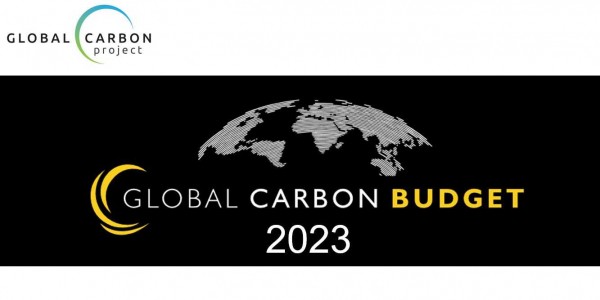Fossil CO2 Emissions at Record High in 2023
Global carbon emissions from fossil fuels have risen again in 2023 – reaching record levels, and far from the steep reduction in emissions that is urgently needed to meet global climate targets, according to the Global Carbon Budget 2023 report, co-authored by GEOG Associate Research Professor Louise Chini, Professor and Associate Chair George Hurtt, Assistant Research Professor Lei Ma, and Research Scientist Ben Poulter. The annual report, produced by the Global Carbon Project, was released during COP28 and has been providing updates on trends in global carbon emissions and sinks since 2006.
The new report shows fossil carbon dioxide (CO2) emissions of 36.8 billion tonnes in 2023, up 1.1% from 2022. Fossil CO2 emissions are falling in some regions, including Europe and the USA, but rising overall – and the scientists say global action to cut fossil fuels is not happening fast enough to prevent dangerous climate change.Emissions from land-use change (such as deforestation) are projected to decrease slightly but are still too high to be offset by current levels of reforestation and afforestation (new forests).
This report marks GEOG’s 10th year contributing the official historical land-use data to the Global Carbon Budget. Chini said: “This year we extended the record globally, and updated the data for both Brazil and Indonesia to include more remote sensing data constraints.” She explained that these data updates will help reduce uncertainties at the national scale and give better understanding of the impacts of land-use change in these regions.

Another GEOG key contribution to the report includes incorporating, for the first time, the new global Ecosystem Demography (EDv3) model for land carbon modelling. “We estimated global annual land carbon sink and emissions from 1700 to 2022, considering the impacts of climate change, elevated CO2 levels, and land use activities on vegetation growth,” said Ma. This next-generation model is designed to enhance the understanding of the terrestrial carbon cycle and inform policy.
“The impacts of climate change are evident all around us, but action to reduce carbon emissions from fossil fuels remains painfully slow,” said Professor Pierre Friedlingstein, of Exeter’s Global Systems Institute, who led the study. “It now looks inevitable we will overshoot the 1.5°C target of the Paris Agreement, and leaders meeting at COP28 will have to agree to rapid cuts in fossil fuel emissions even to keep the 2°C target alive.”
How Long Until We Cross 1.5°C of Global Warming?This study also estimates the remaining carbon budget before the 1.5°C target is breached consistently over multiple years, not just for a single year. At the current emissions level, the Global Carbon Budget team estimates a 50% chance global warming will exceed 1.5°C consistently in about seven years. This estimate is subject to large uncertainties, primarily due to the uncertainty on the additional warming coming from non-CO2 agents, especially for the 1.5°C targets which is getting close to the current warming level. However, it’s clear that the remaining carbon budget – and therefore the time left to meet the 1.5°C target and avoid the worse impacts of climate change – is running out fast.; |
Other Key Findings from the 2023 Global Carbon Budget include:
- Regional trends vary dramatically. Emissions in 2023 are projected to increase in India (8.2%) and China (4.0%), and decline in the EU (-7.4%), the USA (-3.0%) and the rest of the world (-0.4%).
- Global emissions from coal (1.1%), oil (1.5%) and gas (0.5%) are all projected to increase.
- Atmospheric CO2 levels are projected to average 419.3 parts per million in 2023, 51% above pre-industrial levels.
- About half of all CO2 emitted continues to be absorbed by land and ocean “sinks”, with the rest remaining in the atmosphere where it causes climate change.
- Global CO2 emissions from fires in 2023 have been larger than the average (based on satellite records since 2003) due to an extreme wildfire season in Canada, where emissions were six to eight times higher than average.
- Current levels of technology-based Carbon Dioxide Removal (i.e. excluding nature-based means such as reforestation) amount to about 0.01 million tonnes CO₂, more than a million times smaller than current fossil CO2 emissions.
The Global Carbon Budget report, produced by an international team of more than 120 scientists, provides an annual, peer-reviewed update, building on established methodologies in a fully transparent manner.
Published on Wed, 12/06/2023 - 14:17


